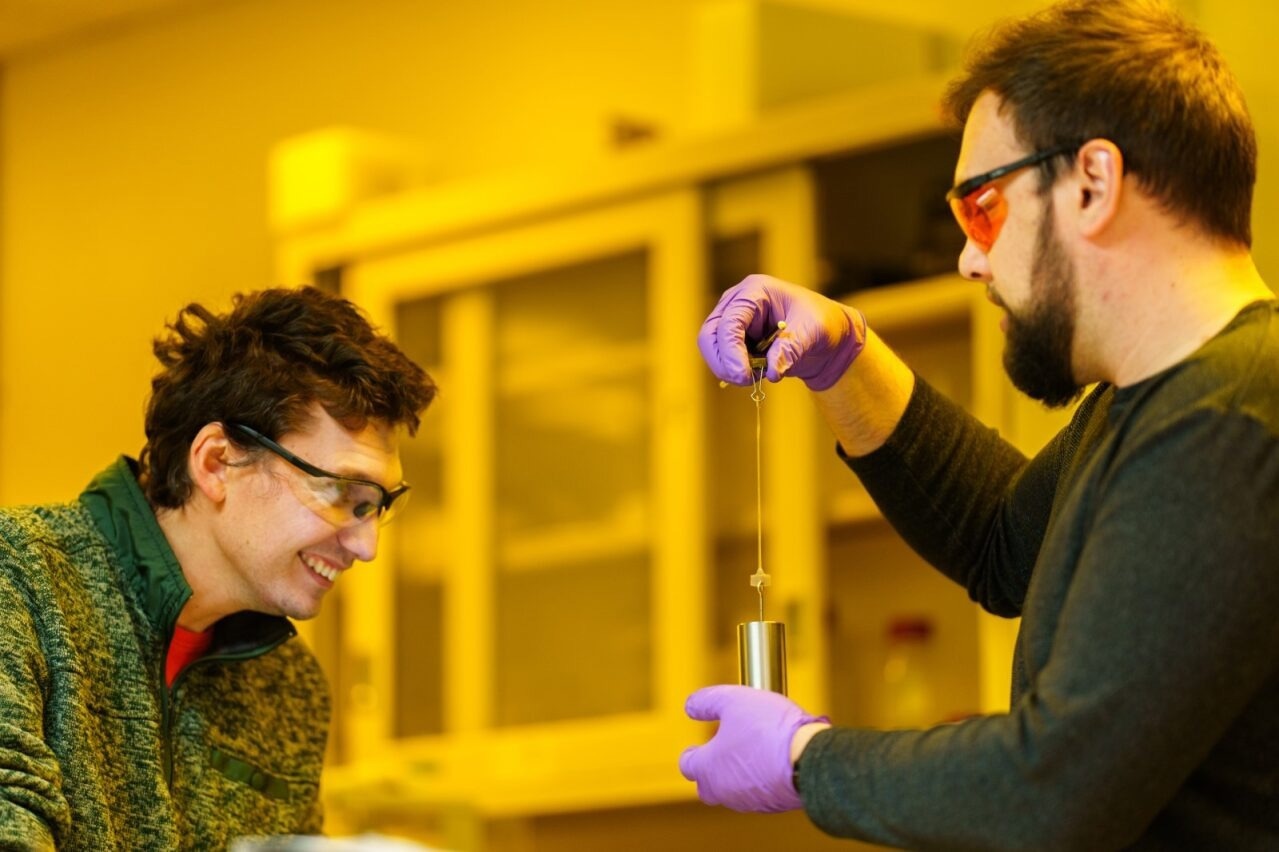3D printing has transformed the world. It has enabled the aerospace, medical, automotive, and industrial industries, among others, to modify components and prototypes in ways that were previously impossible. It has significantly boosted flexibility and cost-effectiveness while decreasing waste and production time. However, many 3D-printed materials are not particularly robust.
 Samuel Leguizamon, left, watches as Alex Commisso stretches 3D material that they printed at Sandia National Laboratories, using Selective Dual-Wavelength Olefin Metathesis 3D-Printing, or SWOMP. Image Credit: Craig Fritz
Samuel Leguizamon, left, watches as Alex Commisso stretches 3D material that they printed at Sandia National Laboratories, using Selective Dual-Wavelength Olefin Metathesis 3D-Printing, or SWOMP. Image Credit: Craig Fritz
Sandia National Laboratories’ chemists and materials scientists are hoping to change that.
They have created a completely novel printing method that produces nonmetallic materials five times quicker than conventional 3D printing and stronger in record time.
It opens up a whole new world of what you can build and what 3D materials can be used for.
Samuel Leguizamon, Senior Scientist, Sandia National Laboratories
SWOMP, or Selective Dual-Wavelength Olefin Metathesis 3D-Printing, was created under his direction. It employs dual-wavelength light, as the name suggests, as opposed to the conventional printing method.
How 3D Printing Works
Traditionally, vat 3D printing involves irradiating a vat of photosensitive liquid resin in the desired pattern.
The resin cures and solidifies into a polymer layer when it is exposed to light from underneath the vat. To cure the next layer, the cured polymer is lifted and a new pattern is projected underneath.
One problem is that the polymer sticks to the bottom of the vat and the layer above it as it cures. To avoid damage, the cured polymer must be carefully peeled from the vat after each layer, which considerably slows down the 3D printing process.
Fellow creator Leah Appelhans compared it to making cookies.
After you bake the cookies, you have to let them cool. If you were to try to peel the warm cookie off the cookie sheet, it’s squishy and it breaks apart. The same thing would happen with a 3D printer if you tried to quickly print each layer. Your work would get deformed.
Leah Appelhans, Sandia National Laboratories
Leguizamon, Appelhans, former Sandia employee Jeff Foster, and polymer scientist Alex Commisso devised a method to cool the “cookies” more quickly.
UV and Blue Light
The key is to combine two lights. In this situation, UV and blue light.
The team was inspired by a technology called continuous liquid interface printing, as well as a printing method for acrylic-based polymerizations that uses dual-wavelength light.
With it, they developed SWOMP.
Leguizamon added, “You are still printing layer by layer, but you are using a second wavelength of light to prevent polymerization at the bottom of the vat. So, it doesn’t adhere to the bottom. That means you can lift the cured polymer part more quickly and speed up the printing process significantly.”
Making 3D Materials Stronger
However, this new method is about more than just efficiency. It is about making 3D-printed materials more durable and multifunctional. Most vat polymerization printed materials are made of acrylic, which is not the strongest substance.
It is really hard to use these materials in things like aircraft and space and aerospace and automotive; they are very harsh environments.
Bob Sleeper, Licensing Executive, Sandia National Laboratories
This team resorted to dicyclopentadiene, a chemical extensively used in the manufacture of paints, varnishes, and plastic flame retardants. They were able to discover a method for polymerizing it more quickly using light, allowing it to be employed more efficiently in 3D printing.
“We changed building blocks of the materials from acrylic-based to olefin-based. Which lets us print materials that are a lot tougher,” Leguizamon added.
Sleeper stated, “That is the beauty of what they are doing. You have very high-quality plastic parts that are made very precisely by using some light in a very novel way.”
Opening a New World of 3D Printing
This team expects that their new printing technique will broaden the scope of 3D printing.
The research was first supported through a three-month Exploratory Express program, which is currently supported by a Sandia technology maturation program.
Appelhans stated, “What we are trying to do is build the toolbox of materials available. We want designers, researchers, engineers to be able to select the type of material they want to use.”
They see future use of these 3D-printed components in batteries, engines, rockets, and perhaps even fusion applications. Leguizamon stated that they had already begun discussing potential uses with researchers at Lawrence Livermore National Laboratory.
“It turns out that monomers are already used in fusion components. You don’t usually think of a polymer used in fusion, but it is really cool and exciting potential,” Leguizamon further stated.
The group envisions a future in which remote locations could more readily undertake 3D printing.
Sleeper added, “We are looking at locations where machinery and parts are not readily available; like in space, on the moon or in the Middle East at a US military base. You can bring with you some lightweight materials and make whatever you need on the spot.”
Leguizamon, who was raised in Wagener, South Carolina, is considering applications that can be useful regionally as well.
He added, “I have horses. I grew up in a rural area, my dad was a farrier, so I’m thinking of ways to make horseshoes for racehorses. They have to be impact-resistant, but by changing the material properties, stress can be better spread out and impact in the right space on the hoof. You could think of it as insoles for horses.”
The options are limitless.
“I think what attracted me to chemistry in the first place is the potential to make something that has never existed before. The fun thing about 3D printing is that you apply that chemical knowledge to something that has a very concrete outcome. Something you can see and hold in your hands,” Appelhans concluded.